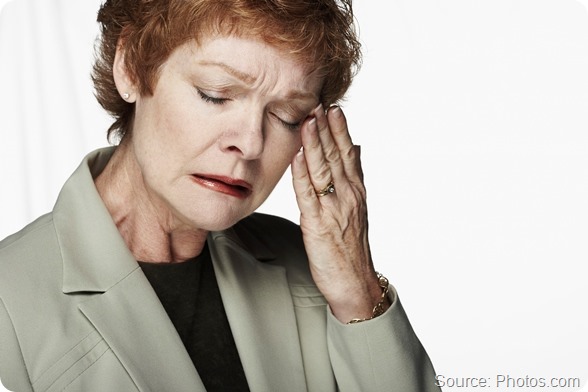By Dr. Dawn Buse

Migraine is a common and disabling neurological condition. Migraine is currently estimated to affect more than 860 million people worldwide.
Migraine has recently been rated by the Global Burden of Disease Study from the World Health Organization as the third most common and eighth most burdensome disease on the planet, and it alone is responsible for 3 % of disability attributable to a specific disease worldwide.1
For the past eight years, I have had the opportunity to work on the American Migraine Prevalence and Prevention (AMPP) Study alongside study primary investigator, Richard B. Lipton, MD and an excellent team of scientists and researchers. We have learned a great deal about migraine from the AMPP Study.
The AMPP study is a longitudinal, population-based study of individuals from the United States with “severe” headache. In 2004, questionnaires were mailed to 120,000 households in the US. Surveys were returned by 162,756 individuals aged 12 and older. 30,721 respondents reported that they ever experienced “severe headache” and 28,261 had experienced “severe headache” in the preceding year.
These responses allowed us to determine that almost 12% of people in the United States (almost 18% of adult women and almost 6% of adult men) have migraine1 and that 1% of people in the US have chronic migraine (a diagnosis of migraine with headache on 15 or more days per month).2
Estimates of the rates of migraine vary slightly around the world, although it is unclear whether the variation in the prevalence of the condition in different countries is due to variations in measurement or issues related to race, ethnicity and society. 2, 3
Recently, The World Health Organization and The Lifting the Burden Campaign against Headache published the “Atlas of Headache Disorders and Resources in the World, 2011”.4
Their worldwide investigation found that rates of migraine were as high as 15-20% of the population in European countries and as low as 4% of African countries with rates in Asian countries being similar to US prevalence rates.5

What is migraine?
Migraine is a chronic condition with episodic manifestations, meaning that while a given individual always has the condition, attacks may occur on an unpredictable or irregular basis.6 Migraine is actually comprised of a constellation of symptoms and diagnosis is based on several criteria.7
Headache is usually the main symptom and can last from 4-72 hours. The headache is often unilateral (one-sided), with pulsating pain, and aggravated by movement or activity such as walking up stairs.
Migraine attacks also often involve nausea, vomiting, photophobia (sensitivity to light), phonophobia (sensitivity to sound), and osmophobia (sensitivity to smell) as well as other associated symptoms.
Migraine attacks can include four stages: prodrome, aura, headache (pain and accompanying symptoms) and postdrome. An attack may include all of these stages or just some. This can vary from person to person, and from attack to attack. The prodrome may occur from 12-24 hours preceding the headache. The migraineur may notice irritability, neck pain or stiffness, food cravings or yawning during this time, among other symptoms.
The aura phase is defined as the experience of “focal neurologic features”. These may be visual in nature, such as seeing flickering lights, spots or lines, or losing a portion of the visual field, but other senses can be involved as well such as a sensory aura where a person may experience numbness or feelings of “pins and needles”. During this period someone may also experience confusion, dizziness or weakness. The aura may last for 5-60 minutes just before the headache begins. Approximately one out of five migraineurs experience an aura before an attack, although they may have auras with only some migraine attacks.
The headache phase may last between 4-72 hours (or shorter if effectively treated). This phase is defined by moderate to severe head pain, but may also include extreme sensitivity to light, sound and odors, nausea and vomiting. These symptoms make it very difficult to function during an attack and migraineurs are commonly confined to bed during this time with a preference for dark and quiet.
The postdrome phase occurs12-24 hours after the headache phase has resolved. Much like the prodrome phase, during this time someone may report not feeling like themselves, feeling fuzzy- headed, in a fog, or fatigued. This phase may involve difficulty with concentration, attention, motivation and fatigue. In light of all four phases, a migraine attack can last for several days and incapacitate someone or limit their ability to function for an extended period of time.
Migraine can be divided into episodic migraine (EM) and chronic migraine (CM) based on the number of days per month that someone experiences headache. Episodic migraine is defined as meeting International Classification of Headache Disorders (ICHD-2) criteria for migraine with fewer than 15 headache days per month. Chronic migraine is generally defined as meeting criteria with 15 or more headache days per month. 8 Some people with chronic migraine experience headache every day, and some people have continuous headache pain.
Research from the AMPP Study has shown that approximately 2.5% of people with episodic migraine one year develop chronic migraine the following year. We also identified some factors which might increase the probability of this transition including some that are not possible or easy to change (e.g., sex, age, traumatic brain injury, adverse childhood experiences) and some that are potentially modifiable (e.g., number of headache days per month, obesity, medication overuse, caffeine overuse, stressful life events, depression, and anxiety).
Migraine can affect all aspects of life including work, school, family life, social life, hobbies, mood and general well-being. 9 It can be very difficult to function during attacks and individuals may end up missing a great deal of work and school, family and social activities.
In addition, it can be difficult to plan or make commitments due to uncertainty about when the next attack will occur. We refer to this as “interictal” burden or anxiety.
Migraine is associated with several medical and psychiatric comorbidities. Comorbidity is the occurrence of two conditions at rates higher than expected by chance. Common psychiatric comorbidities of migraine include depression, anxiety, panic disorder, post-traumatic stress disorder, adverse childhood experiences (e.g., physical, emotional and sexual abuse) and suicide attempts. 10, 11
It is not clearly understood in many cases whether one condition causes the other, or they both develop out of shared underlying genetic or biological predispositions. In the case of migraine and depression, it has been shown that they are bidirectional, and each condition places those who experience one at a higher risk for the other. 12
Medical comorbidities of migraine include epilepsy, stroke, cardiovascular disease, sleep disorders (e.g., insomnia, restless leg disorder, and sleep apnea), musculoskeletal disorders, chronic pain conditions (e.g., fibromyalgia, chronic back pain), obesity, respiratory disorder (e.g., asthma, allergic rhinitis), irritable bowel disease, cervical dystonia, celiac disease, chronic fatigue and other conditions. All of these conditions are even more prevalent among people with chronic migraine.10
What causes migraine?
Migraine has been documented since the beginning of recorded human history. It was mentioned in scrolls buried with Egyptian mummies in 1500 BC and in writings from ancient Babylon from around 300 BC. However, our scientific understanding of migraine is constantly evolving.
Migraine has a strong biological component and it is most likely caused by a combination of genetic and environmental factors. Findings from twin studies suggest that approximately half of the risk for migraine comes from our genes. This means that an individual with one parent with migraine has a 50% chance of inheriting the disease whereas someone with both parents with migraine has a 75% chance. More than 50% of people with migraine have at least one close relative with migraine.
Migraine is also sex related. Both EM and CM occur in females at two to three times the rate of males. Migraine often begins in adolescence or early adulthood, but rates peak in midlife. Rates of migraine tend to be lower before puberty and after midlife, especially after menopause for women.
Someone with migraine has a sensitive nervous system. A migraine attack can happen when the combination of biological and environmental factors (i.e., triggers) exceeds a certain biological threshold. This threshold can change based on various factors.
Triggers can include stress, relaxation after a stressful period, too much or too little sleep or changing sleep patterns (for example: on the weekend or a change in time zones), hunger, fasting, skipping meals or dehydration, bright or flickering lights, sustained loud noise, strong odors, weather changes and certain foods such as aged cheese and some alcoholic drinks among other factors. In many women, hormonal changes may trigger migraine.
A combination of triggers may set the perfect stage for a migraine attack. For example, a college student may feel stress studying for finals week, then not get enough sleep and skip some meals, leading to an attack. Triggers vary from person to person and from attack to attack. The best way to identify triggers is to keep a headache diary and note all factors related to an attack.

What are the treatments for migraine?
Treatment of migraine includes both medication (pharmacological) and non-medication approaches.
Pharmacologic approaches can be acute, meaning that they are intended to be used when pain occurs, or preventive, which are medications that are taken on a daily or regular basis in order to prevent attacks.
There are also some preventive approaches that are given through non-oral routes of administration such as trigger point injections, nerve blocks, or a series of injections as in the case of onabotulinumtoxinA (i.e., Botox).
Most pharmacologic treatments carry the risk of side effects and/or may not be appropriate for certain individuals based on medical history, age or by women who are pregnant or nursing.
Non-pharmacologic treatments for migraine management are equally as important in a treatment plan. They may be used in conjunction with pharmacologic therapies or alone. They are safe for all life stages including during pregnancy and nursing.
Several behavioral treatments have been demonstrated to be as effective as the most effective preventive pharmacologic therapy.13, 14 These include biofeedback, relaxation training, and cognitive-behavioral therapy.15
Acute migraine medications can be over the counter (OTC) or by prescription. OTC medications include general pain relieving medications such as nonsteroidal anti-inflammatory medications (NSAIDs) such as ibuprofen, pain relievers such as acetaminophen and the combination of acetaminophen, aspirin and caffeine. These medications can actually increase the frequency of headache if taken too often and can lead to medication overuse headache or rebound headache. If used too often, some medications can also increase the risk of transition from EM to CM.16 There are also migraine-specific prescription medications called triptans. Ergots and dihydroergotamine (an ergot derivative) may also be prescribed for migraines.
Many people with migraine use a combination of medications, and may use some in the case of more mild headaches and others in the case of more severe headaches, or they may be prescribed a combination or medications such as a triptan and an NSAID. Some people may also take anti-nausea medications in addition to pain relieving medications because nausea is common with migraine attacks.
Some people use opioid or narcotic medications for migraine pain relief; however, this is not advised according to US Headache Consortium guidelines17 as these medications can be sedating and also carry the risk of dependence.18 Several new migraine treatments are currently in development.19
People with chronic migraine or higher frequency episodic migraine may use preventive medications. While there are no preventive medications that have been developed specifically for migraine, several classes of medications are used to reduce the frequency of migraine attacks including: cardiovascular, anti-seizure, antidepressants, and neuromodulators. OnabotulinumtoxinA (i.e.., Botox) is US FDA approved for the treatment of chronic migraine and is administered as a series of injections occurring once every 3 months.
Behavioral approaches are key components for successfully living with migraine. Scientifically validated non-pharmacologic treatments for migraine management include biofeedback, relaxation training, and cognitive-behavioral therapy.20
In addition, trigger awareness and management, stress management and maintaining a healthy lifestyle are very important for everyone in preventing or managing attacks. The most important lifestyle habits include maintaining a regular sleep/wake schedule, practicing good sleep hygiene, eating healthy regular meals, staying hydrated, getting regular exercise, not smoking, and moderating caffeine use. These actions can raise the threshold for attacks.
Practicing relaxation techniques such as meditation, guided visual imagery, yoga, or other ways to quiet the mind can also have beneficial effects. If stress, depression, anger or anxiety seem unmanageable on one’s own it is wise to speak to a mental health professional. (See “resources” section for links for guided relaxation practice and how to find a mental health professional).

Summary and recommendations
Through our work on the AMPP Study we continue to learn about migraine and the people who live with this condition. Most recently, we learned that a minority of people with migraine have ever sought medical treatment for their condition, received a diagnosis or are using migraine specific pharmacologic treatments.21, 22
We also learned that a very small percentage of those with migraine use the scientifically proven behavioral approaches to migraine. While research efforts are ongoing to develop new, effective treatments for migraine, migraine is currently not curable.
The best approach is to manage the condition through a combination of pharmacologic and non-pharmacologic approaches. It is wise to keep a diary to identify triggers, and use that information to avoid them.
Practicing stress management and relaxation techniques can help lower the migraine threshold and make attacks less likely. If stress, depression or anxiety feels unmanageable, speak with a mental healthcare provider for help.
If migraine attacks are frequent and/or severely disabling, talk with a healthcare provider about prescription medications including preventive treatment options.
With a proper diagnosis, medical care, and an effective treatment plan that includes pharmacologic therapies (acute and preventive as appropriate), non-pharmacologic treatments, healthy lifestyle habits and trigger management, people with migraine can live healthy, productive lives.
Further Reading
About Dawn C. Buse, PhD
 Dawn C. Buse, PhD, is an Associate Professor in the Department of Neurology of Albert Einstein College of Medicine of Yeshiva University and Assistant Professor in the Clinical Health Psychology Doctoral Program of Ferkauf Graduate School of Psychology of Yeshiva University in New York, NY. She is a licensed clinical psychologist and the Director of Behavioral Medicine for the Montefiore Headache Center. She is also a fellow of the American Headache Society.
Dawn C. Buse, PhD, is an Associate Professor in the Department of Neurology of Albert Einstein College of Medicine of Yeshiva University and Assistant Professor in the Clinical Health Psychology Doctoral Program of Ferkauf Graduate School of Psychology of Yeshiva University in New York, NY. She is a licensed clinical psychologist and the Director of Behavioral Medicine for the Montefiore Headache Center. She is also a fellow of the American Headache Society.
Dr. Buse has published widely and lectured internationally on behavioral treatments for headache and pain and the burden of migraine and its comorbidities including depression, anxiety, abuse, and cardiovascular risk. She has coauthored more than 100 publications in scientific journals and books, presented more than 220 scientific abstracts.
She and her colleagues have won the American Headache Society “Wolff Award” and the Italian Society for the Study of Headaches “Enrico Greppi Award” for their research on migraine. She is a co-investigator on the American Migraine Prevalence and Prevention (AMPP) Study, a large, longitudinal US population-based study. See www.dawnbuse.com for a complete list of AMPP Study abstracts and her other research articles.
At the Montefiore Headache Center in New York, NY, Dr. Buse treats patients with migraine, pain, depression, anxiety and other disorders with a combination of cognitive behavioral therapy, biofeedback, relaxation training, mindfulness, and stress management. She also shares these pain and stress management techniques including diaphragmatic breathing and guided visual imagery with free audio files on her website at www.dawnbuse.com.
Twitter: @dawnbuse
Further information
Internet resources for information on migraine and other headaches
How to find a provider of cognitive behavioral therapy or biofeedback in the US
Sponsorship Note
The American Migraine Prevalence and Prevention Study was funded by a research grant to the National Headache Foundation from McNeil-Janssen Scientific Affairs LLC, Raritan, NJ. The AMPP Study database was donated by McNeil-Janssen Scientific Affairs LLC to the National Headache Foundation in 2009.
References
- Murray CJL, Ezzati M, Flaxman AD et al GBD 2010: design, definitions, and metrics. Lancet, 2012;380:2063–2066.
- Stovner L, Hagen K, Jensen R, Katsarava Z, Lipton R, Scher A, et al. The global burden of headache: A documentation of headache prevalence and disability worldwide. Cephalalgia, 2007;27:193-210.
- Buse DC, Lipton RB. Global perspectives on the burden of episodic and chronic migraine. Cephalalgia, 2013, Epub ahead of print.
- World Health Organization and Lifting the Burden Campaign Against Headache. Atlas of headache disorders and resources in the world 2011. Geneva: WHO; 2011.
- Buse DC, Lipton RB. Global perspectives on the burden of episodic and chronic migraine. Cephalalgia, 2013;33(11) 885–890.
- Haut, S.R., Bigal, M.E., Lipton, R.B. Chronic disorders with episodic manifestations: focus on epilepsy and migraine. Lancet Neurology, 2006; 5:148-157.
- Headache Classification Committee of the International Headache Society (IHS), The International Classification of Headache Disorders, 3rd edition (beta version). Cephalalgia. 2013; 33(9) 629–808.
- Olesen J, Bousser MG, Diener HC et al. New appendix criteria open for a broader concept of chronic migraine. Cephalalgia. 2006;26:742-746.
- Buse, D.C., Rupnow, M.F.T., Lipton R.B. Assessing and managing all aspects of migraine: Migraine attacks, migraine-related functional impairment, common comorbidities, and quality of life. Mayo Clinic Proceedings 84:422-435, 2009.
- Buse, D.C., Manack, A., Serrano, D., Turkel, C., Lipton, R.B. Sociodemographic and comorbidity profiles of chronic migraine and episodic migraine sufferers. Journal of Neurology, Neurosurgery, and Psychiatry 81:428-432, 2010.
- Buse, D.C., Silberstein, S.D., Manack, A.N., Papapetropoulos, S., Lipton R.B. Psychiatric comorbidities of episodic and chronic migraine. Journal of Neurology 2012, Nov 7. [Epub ahead of print].
- Breslau N, Davis GC. Migraine, physical health and psychiatric disorder: a prospective epidemiologic study in young adults. J Psychiatr Res 1993;27(2):211–221.
- Holroyd KA, Cottrell CK, O’Donnell FJ, Cordingley GE, Drew JB, Carlson BW, Himawan L. Effect of preventive (β blocker) treatment, behavioural migraine management, or their combination on outcomes of optimised acute treatment in frequent migraine: randomised controlled trial. BMJ. 2010;341:c4871. doi:10.1136/bmj.c4871.
- Goslin RE, Gray RN, McCrory DC, Penzien D, Rains J, Hasselblad V. Behavioral and Physical Treatments for Migraine Headache Technical Review 2.2, February 1999. Prepared for the Agency for Health Care Policy and Research under Contract No. 290-94-2025. Available from the National Technical Information Service; NTIS Accession No. 127946.
- Buse, D.C., Andrasik, F. Behavioral medicine for migraine. Neurologic Clinics 27:321- 582, 2009.
- Bigal, M.E., Serrano, D., Buse, D., Scher, A., Stewart, W.F., Lipton, R.B. Acute migraine medications and evolution from episodic to chronic migraine: A longitudinal population-based study. Headache. 2008;48:1157-1168.
- Silberstein SD. Practice parameter: evidence-based guidelines for migraine headache (an evidence-based review): report of the Quality Standards Subcommittee of the American Academy of Neurology. Neurology. 2000;26:55(6):754-62.
- Buse, D.C., Pearlman, S.H., Reed, M.L., Serrano, D., Ng-Mak, D.S., Lipton, R.B. Opioid Use and Dependence among Persons with Migraine: Results of the AMPP Study. Headache 52(1), 18-36, 2012.
- Vollbracht S, Rapoport AM. The pipeline in headache therapy. CNS Drugs. 2013;27(9):717-29.
- Buse, D.C., Andrasik, F. Behavioral medicine for migraine. Neurologic Clinics 27:321- 582, 2009.
- Lipton RB, Serrano D, Holland S, Fanning KM, Reed ML, Buse DC. Barriers to the Diagnosis and Treatment of Migraine: Effects of Sex, Income and Headache Features. Headache.2013;53(1):81-92.
- Lipton, R.B., Buse, D.C., Serrano, D., Holland, S., Reed, M.L. Examination of Unmet Treatment Needs among Persons with Episodic Migraine: Results of the American Migraine Prevalence and Prevention (AMPP) Study. Headache, 2013, epub ahead of print.
Disclaimer: This article has not been subjected to peer review and is presented as the personal views of a qualified expert in the subject in accordance with the general terms and condition of use of the news-medical.net website.
Last Updated: Jan 20, 2023